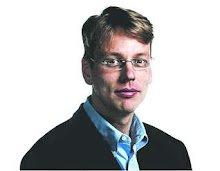Printed in the Iowa City Press-Citizen, Feb. 10, 2010.
By Jeff Charis-Carlson, Iowa Cityscapes
Last year, John D'Agata, an associate professor at the University of Iowa, explained to me his vision of what literary nonfiction writing is all about.
Beholden neither to a journalist's commitment to veracity nor to the strictures of academic argument, he said, the creative nonfiction writer is free to produce essays that allow readers to experience the world -- essays that strive to "enact the world."
"If the critic fails to prove his case, then his essay is a failure," D'Agata said. "For us, it's quite the opposite. There are no promises made. No guarantees that answers will be found or that problems will be solved."
In "About a Mountain," D'Agata lives up to that vision by providing an enjoyable, fast-paced yet highly literary account of the federal government's plan to store nuclear waste at Yucca Mountain.
But that's far too straight-forward a summary of the many things included in this book. Yes, D'Agata provides in-depth readings of the lengthy congressional debates on Yucca Mountain -- and it's simply amazing how many inconsistencies one writer can find and lampoon when reading through transcripts and news reports. But "About a Mountain" also manages to tell very personal and human stories of the seductive allure of Los Vegas.
D'Agata himself is a constant presence in the book as he narrates his experiences in Las Vegas doing research. But "About a Mountain" has nothing in common with the gonzo journalism of earlier generations. In fact, Scott Dickensheets of the Los Vegas Weekly says that it's hard to think of "a Vegas book that's more opposite of the Hunter Thompson approach."
Instead, D'Agata lives up to his vision of having the facts and stories in nonfiction proceed "less journalistically and more processionally." He moves effortlessly between readings of government policy documents, accounts on the history of nuclear waste, passages about his mother and efforts to put a human face on Vegas's high suicide rate. And in the book's best chapter, D'Agata describes and enacts the linguistic difficulty of writing a sign that still will convey "DANGER" to whatever humans happen to be strolling around the still radioactive Yucca site 10,000 years from now.
D'Agata promises neither answers nor solutions, but if you need help figuring out what unifying narrative force helps tie all this together into one book, you can ask him in person after he reads at 7 p.m. today in Van Allen Hall 2 or during the book signing at Prairie Lights afterward.
Opinion editor Jeff Charis-Carlson can be contacted at jcharisc@press-citizen.com or 319-887-5435.

Let me say this, though: Factual veracity shouldn't be considered optional. Much as I liked long stretches of D'Agata's book, he got some easy facts just flat wrong. Highway designations, distance measurements — cub-reporter stuff like that. Which, frankly, caused little fissures of disappointment in the book that affected my reading of it.
ReplyDeleteBut you are exactly right about the section on signage. That's terrific, a great indication of what creative nonfiction can do. I love the way it literalizes the book's theme of the unknowability of things. Great stuff.